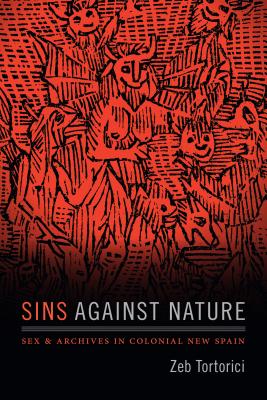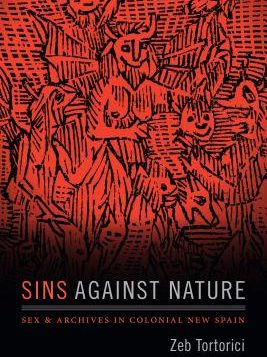 Sins Against Nature: Sex & Archives in Colonial New Spain
Sins Against Nature: Sex & Archives in Colonial New Spain
by Zeb Tortorici
Duke. 327 pages, $28.95
IN THE COURSE of an ecclesiastical trial, Father Juan Vallejo eventually confessed to having sex with 115 men and boys. He had been denounced by a servant for “committing the abominable, obscene, and foul sin of sodomy” for over eleven years. He died before the trial was completed; therefore, he faced no sentence. This is not a contemporary case but dates from Mexico City in 1712. What had been covered over in the archival dust has become front-page news today.
Last February, Theodore E. McCarrick (a prominent American cardinal and archbishop of Washington) was defrocked by the Vatican for soliciting sex during confession and for decades of sexual abuse of minors and seminarians. For the past two decades, the Catholic Church has been confronting (or trying to silence) an expanding global scandal of priestly sexual abuse of minors, seminarians, nuns, and congregants (male and female), as well as covering up abortions and priests’ illegitimate children. The current cases date back to the 20th century. However, as Zeb Tortorici’s Sins Against Nature proves, the Catholic Church has meticulously investigated, documented, and largely kept silent on priestly sexual abuses for centuries. The matter of priestly “sodomy” and solicitation in the confessional is only one aspect of Tortorici’s research project: secular and ecclesiastical court documentation of sexual crimes (sodomy, bestiality, solicitation in the confessional, and sexual desecrations) from 1530 to 1821 in colonial New Spain (i.e., the Americas and the Philippines).
Tortorici divides his book almost equally between analysis of these documents and academic self-analysis (at times verging on self-flagellation). He is keenly aware of the pleasures of the scholar, particularly in the history of sexuality. The discovery of ancient archival materials (perhaps unseen for centuries), the layers of dust, the smell of parchment are real thrills that keep a researcher digging. I was reminded of my own naughty delight in having elderly librarians retrieve volumes on masturbation, fetishism, and pederasty from the “X Safe” at the Countway Library of Medicine at Harvard.
In dealing with issues of sexuality, the researcher not only has to be mindful of projecting contemporary categories onto the past, but also of the titillation and voyeurism of uncovering sexual acts, just as historical witnesses did in the past: those who denounced sodomites, those who admitted to bestiality, torturers who extracted confessions, and the nameless translators, scribes, and archivists who documented and preserved these “sins against nature.” Tortorici has done a meticulous job of excavating and examining these documents with extensive footnotes, including the original Spanish text conveniently, and undoubtedly laboriously, transcribed from manuscripts.
What began as dissertation research on “same-sex desire” in colonial Mexico morphed into a broader exploration. Tortorici had to grapple with the fact that centuries ago same-sex desire was an amorphous sin that overlapped with a variety of illicit acts. Jurisdiction over investigating and judging these acts in colonial New Spain was divided among secular authorities, church (ecclesiastical) courts, and tribunals of the Inquisition (in cases of acts or statements that could be deemed heretical). Sodomy cases were largely judged by local, secular Spanish or indigenous authorities. Many of the cases involved sex with minors or with servants who were non-Spaniards (indigenous, mestizo, mulatto, or black). The issue of sexual abuse, however, seems to have been secondary to determining if there had been “perfect sodomy” (male anal penetration with ejaculation). Archived sodomy trials peaked in 1658, when over a hundred men of all races from Mexico City and Puebla were arrested and interrogated for sodomy, culminating in the execution of fourteen. Over the centuries, many other men were publicly shamed, sentenced to lashes and hard labor, exiled from their hometowns, or executed by being garroted or burned at the stake. In the bestiality cases, the animals suspected of being violated were routinely killed and incinerated.
Tortorici has unearthed over two dozen cases of priests tried by the Church for sodomy, solicitation during confession, or heretical justifications for coercing sex. The ecclesiastical cases are the most detailed, though perhaps the Church was just more meticulous in documenting and preserving these trial records. Tortorici approaches these “documents” with salutary skepticism on multiple historical grounds. Just how representative of past sexuality are they? Who got arrested, and which cases were documented, preserved, and catalogued for later discovery? Did scribes accurately translate and document statements, particularly by indigenous-language speakers? Were these truthful or coerced? Despite the surprising detail of some of the documentation, we can never be sure what was the “truth”—of either the sexual acts or erotic desires of these historical figures.
Although Tortorici was hoping to uncover evidence of women’s same-sex intimacy in the colonial archives, he is disappointed to find little evidence of it compared to male sex. Of course, this does not mean that it didn’t exist, only that it was not documented, or the documents were destroyed. As many other historians of lesbian sexuality (indeed of women generally) have pointed out, male authorities paid much less attention to women. However, Tortorici unearths some tantalizing material. A judicial summary of 22 different criminal “Case Documents against Diverse Persons for the Sin of Bestiality and Sodomies” from 18th-century Mexico refers to one woman out of 36 people accused. The manuscript, in a mere six lines, summarizes a 1732 criminal case against one Josepha de Garafias for the “crime of sodomy she perpetrated with other women.” She was sentenced to caring for poor women in the hospital of San Juan de Dios for two years. She was also forced to undergo “different medicinal penitences,” which makes me wonder if she was treated for hysteria, the disease of a “wandering womb.” Finally, the judge ordered, “among other things be burned certain instruments she used for her clumsy offence [torpe delicto].” The fleeting reference to the burning of a dildo is not the most scandalous trace of female eroticism in the archives.
Tortorici discusses one of the most explicit descriptions of female eroticism I have encountered from this period. The case of Agustina Ruiz, curiously enough, is preserved at the Bancroft Library of the University of California, Berkeley, in a cache of Mexican Inquisition manuscripts acquired in 1996. The case is sandwiched between Inquisition trials from 1593 to 1817 for apostasy, polygamy, heresy, witchcraft, practicing Judaism, having revelations and clairvoyance, and “seeking sexual intercourse with a woman by telling her God had ordered it.” In 1621, a Spanish priest from Querétaro, Mexico, denounced the twenty-year-old Ruiz after she failed to complete her confession. Ruiz was a mestiza orphan who had been seduced as a pre-teenager by a Spaniard, who a few years later left her a widow. She and her seven-year-old son were later placed (probably in service) with a Spanish family. Her case was tried by the Inquisition, since it raised issues of heresy. Tortorici points out that the case is one of the longest documented: 140 manuscript pages. Through the course of three interrogations, Ruiz went from denying any wrongdoing to confessing ever more explicit erotic thoughts and actions deeply tied to her religiosity. Since the age of eleven, she had daily committed the sin of “self-pollution” (masturbation) at home and in church, while thinking of or ecstatically speaking with saints, Jesus, and the Virgin Mary. Her third and “true confession,” as conveyed by a scribe, is startling in its sexual explicitness interwoven with religious fervor. I provide my translation with original, scant punctuation to convey the challenge of deciphering these old texts (which Tortorici renders in more approachable English):
And with the Virgin with kisses and hugs they called each other you [informal, tú] and you [formal, vos] and my soul and my life my love and tempted each other’s dishonest parts asking what entices you and what tempts me in you and responding the cunt [coño] for you to rub and responding the cunt [crica] and saying this they took turns being the man with the finger and the hand being a dick [carajo]and they penetrated each other and had the pleasure as if a man were fucking them and they called each other street-walking fucking sluts [putas meneadoras hodedoras] and they spoke of what would give them the most pleasure but they did not lie on top each other nor did they join their dishonest parts and that these acts with the saints and Christ and the Virgin were in bed, and she heard their words clearly as if speaking with these men and women … [who]told her and led her to understand that the reward for her love and friendship would be enjoyed in this life and later in heaven she would be declared a great saint. [Emphasis in the original.]
This cannot be simply reduced to an example of “lesbian desire.” Tortorici highlights the interwoven threads of meaning in Ruiz’ trial and confession. A mestiza woman expresses the syncretic efforts of the Church to blend European divine intercession and indigenous pagan beliefs. For example, physical penetration is suffused with divine piercing, as in the stigmatization of St. Francis of Assisi. Erotic debasement becomes one with saintly self-mortification. Neither colonial judges nor readers today can distinguish religious visions from willful fantasies from hallucinatory delusions.
While the other cases in Sins Against Nature are not quite so lengthy and explicit, they are all equally rich in their layering of cultural complexity: religious versus secular, indigenous versus colonial, action versus desire. Tortorici helps us appreciate the challenges of understanding sexuality, not only in colonial New Spain but also in the present.
Vernon Rosario is a clinical associate professor of psychiatry at UCLA and a historian of science.






